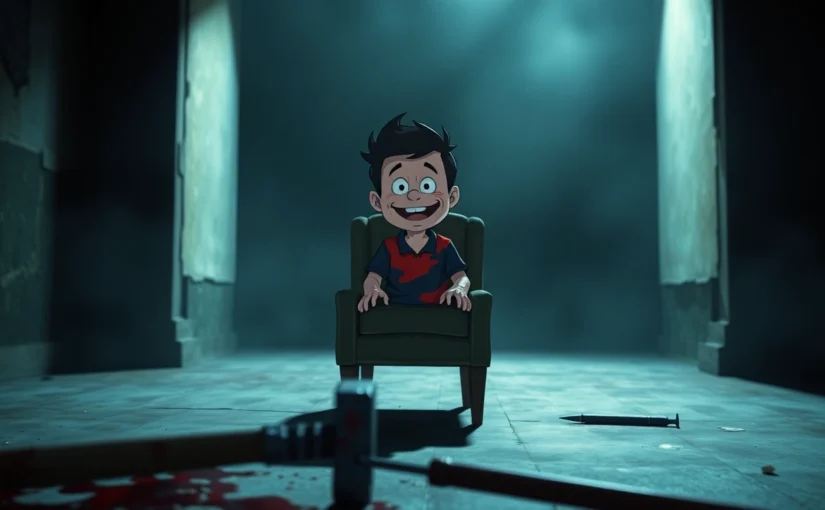Overview and Context: BloodMoney — A Dark Clicker Descent into Morality
In the realm of psychological horror and morally charged gaming experiences, blood money stands out as a harrowing exploration of human ethics, desperation, and the dark side of survival. Unlike traditional clicker games that focus on accumulation and progression, BloodMoney immerses players in a disturbing narrative where each click is a moral choice, each upgrade a step deeper into psychological decay. The game masterfully combines simple mechanics with a haunting atmosphere, prompting players to confront uncomfortable truths about morality and human nature. In this comprehensive exploration, we delve into the mechanics, narrative depth, community insights, and broader implications of BloodMoney, a game that challenges players to ask: How far are you willing to go when your life hangs in the balance?
BloodMoney Game Mechanics: The Fundamentals of Descent
Clicking for Survival: The Core Gameplay Loop
At its heart, BloodMoney is a dark take on the clicker genre. The player is tasked with raising $25,000 to cover urgent medical bills, a realistic and relatable dilemma that immediately grounds the game’s unsettling premise. To do so, players click on Harvey, a cheerful, seemingly innocent character who offers a simple solution: click on him to generate money. Each click earns a dollar, but at a cost—Harvey experiences increasing pain, visually and psychologically. As the game progresses, the clicking mechanic becomes more than just a means to an end; it becomes a moral battleground. The more you click, the more Harvey suffers, and the game subtly tracks these actions to influence the ending.
Upgrade System: From Innocence to Violence
The shop in BloodMoney introduces upgrade tools that escalate in brutality. Initially, players can purchase benign items like pillows, which seem harmless and align with Harvey’s cheerful persona. As the urgency to reach the financial goal intensifies, more violent tools such as needles, hammers, and knives become available. Each upgrade boosts earnings but at a profound moral and visual cost. For example, using a hammer increases profit exponentially but causes Harvey to visibly suffer more, with graphic reactions and deteriorating visuals. These upgrades are designed to create a twisted risk-reward dynamic, compelling players to decide whether maximizing profit is worth Harvey’s pain.
Visual Decay and Psychological Horror
BloodMoney employs subtle visual cues to heighten the psychological horror. Harvey’s appearance gradually deteriorates—his expressions shift from cheerful to fearful, and the environment around him darkens with each violent upgrade. The game’s audio design complements this decay, with unsettling sounds, whispered dialogue, and an increasingly oppressive atmosphere. This combination of visual and auditory elements immerses players in Harvey’s growing distress, blurring the lines between game mechanics and emotional impact. The decay is not merely aesthetic; it symbolizes the moral degradation of the player and the increasing severity of their choices.
The Dark Narrative of BloodMoney
Harvey: Innocence, Suffering, and Subtle Clues
Harvey appears as an upbeat, friendly character—almost a mascot—whose surprise at more violent tools hints at a deeper story. Observant players notice Harvey’s reactions, such as his shock when confronted with a needle or a hammer, suggesting he might not fully understand what he’s involved in. These subtle cues imply that Harvey is not merely a willing participant but perhaps a victim of darker forces or a manipulated entity. His innocence contrasts sharply with the cruelty of the shop and the escalating violence, embodying the game’s central moral tension.
The Narrative Arc: From Hope to Horror
The game’s storyline is minimal but potent, focusing on the moral choices the player makes. Initially, the player’s goal feels straightforward—raise funds to survive. However, as the visual and narrative cues intensify, the underlying horror becomes apparent: the player is complicit in Harvey’s suffering, and their choices mirror real-world ethical dilemmas. The game does not impose a fixed story but allows players to interpret their actions—whether they choose minimal harm, moderate violence, or maximum efficiency—leading to one of three endings.
Harvey’s Proposition: A Desperate Offer
The narrative hinges on Harvey’s proposition: click to earn money. This simple premise spirals into a moral abyss, forcing players to confront their own boundaries. As Harvey’s suffering mounts, players may question their motivations—are they driven solely by survival, or are they complicit in cruelty? The game’s layered storytelling encourages reflection on how desperation can distort morality and how easy it is to justify morally questionable actions when stakes are high.
Featured Gameplay Videos: A Window into the Experience
Community creators and gamers have shared numerous gameplay videos that showcase BloodMoney’s unsettling atmosphere and decision-making complexity. These videos often highlight key moments—such as the first violent upgrade, Harvey’s reactions, and the different endings—helping new players understand the depth of the game’s moral dilemmas. Watching others navigate the game can reveal subtle strategies for achieving specific endings or illustrate the emotional toll of certain choices, fostering a community of discussion and moral debate.
Clicking Mechanics and Player Strategy
Timing, Efficiency, and Moral Choices
The core clicking mechanic is deceptively simple but becomes complex as players weigh their options. Should they click rapidly to reach the goal faster, risking greater suffering for Harvey? Or should they limit clicks, minimizing harm but prolonging the journey? Different strategies emerge—some players prioritize efficiency, pushing Harvey to the brink for maximum profit, while others attempt to minimize pain, accepting a slower progression. The game’s tracking of player behavior influences the narrative and the ultimate ending, adding an element of unpredictability.
Upgrade Pathways: Choosing Your Moral Compass
The upgrade system offers multiple pathways, each reflecting a different moral stance. For instance, choosing the pillow may be viewed as the least harmful, aligning with the “Good Ending,” whereas hammer or knife upgrades lean toward the “Bad Ending.” Interestingly, some players discover that even with more violent tools, it’s possible to achieve the positive endings through specific playstyles—suggesting that the game tracks nuances in decision-making beyond simple upgrade choices.
Multiple Pathways: Diverse Endings and Moral Implications
The Good Ending: Minimal Harm, Hope, and Reflection
Achieving the Good Ending requires players to limit Harvey’s suffering, often by choosing the least violent tools and avoiding unnecessary harm. The narrative concludes with Harvey surviving relatively unscathed, and the player reflecting on their moral restraint. This ending emphasizes compassion and moral integrity, even in desperate circumstances. It prompts players to consider the value of empathy over profit, highlighting that even in bleak situations, kindness can prevail.
The Normal Ending: Balanced Approach and Acceptance
The Normal Ending is attainable through moderate violence—using scissors or similar tools—and involves a compromise between profit and suffering. Harvey’s appearance shows signs of distress, but he survives. The ending suggests a resignation to morally gray choices, acknowledging that survival often requires difficult compromises. It serves as a reminder that moral choices are rarely black and white, especially under pressure.
The Bad Ending: Maximal Efficiency at a Cost
The Bad Ending is achieved by maximizing violence—using hammers, knives, or other brutal tools—causing Harvey significant pain. The game’s visuals become increasingly disturbing, and Harvey’s reactions grow more desperate. This ending portrays a complete moral collapse, emphasizing greed and ruthlessness. It raises hard questions: What are we willing to sacrifice for survival? The game leaves players with a haunting reflection on the consequences of unchecked morality.
The Desperate Situation: Medical Bills and Moral Choices
The Player’s Dilemma
The core of BloodMoney revolves around an urgent need: raise $25,000 for medical treatment. This realistic predicament heightens the emotional stakes, making the moral choices more visceral. The ticking clock adds pressure—how quickly can you reach your goal before tragedy strikes? The game’s pacing and visual decay mirror the escalating desperation, forcing players to confront their own thresholds.
Harvey’s Proposition: A Moral Crossroads
Harvey’s cheerful demeanor masks a darker truth—each click causes him pain, and each upgrade pushes him closer to suffering. The game invites players to reflect: Is survival worth the moral cost? As Harvey’s suffering intensifies, players must choose whether to prioritize their health or succumb to greed. The narrative’s open-endedness allows for a range of interpretations, encouraging moral introspection.
About BLOODMONEY and Related Games
BloodMoney is part of a broader landscape of dark, thought-provoking indie games that challenge traditional notions of morality and gameplay. Its unique blend of psychological horror and clicker mechanics sets it apart, offering a visceral experience that lingers long after play. The game’s influence extends into discussions on ethics in gaming, psychological resilience, and the human capacity for cruelty and kindness.
Related titles and community projects continue to explore similar themes, pushing the boundaries of narrative-driven horror and moral complexity. As an educational and entertainment piece, BloodMoney exemplifies how games can serve as mirrors to our darkest impulses and brightest virtues.
Connect With Us and Community Insights
The BloodMoney community is vibrant, with players sharing their experiences, theories, and emotional reactions through videos and forums. Many discuss their moral philosophies—whether they aimed for the Good, Normal, or Bad endings—and reflect on what these choices reveal about human nature. The game’s open-ended design fosters rich discussions on morality, ethics, and the psychological impact of desperation.
Content creators, like ShroomyChrist and others, have produced gameplay videos that analyze the game’s mechanics and narrative layers. These insights help new players grasp the emotional depth and moral implications embedded in each decision. Community feedback continues to shape the game’s cultural footprint, prompting ongoing debates about the balance between survival and morality.
Broader Reflections: Morality, Humanity, and Survival
BloodMoney is more than a game; it is a mirror reflecting the complex interplay between morality and necessity. It questions whether human nature is inherently good or evil, especially when faced with life-threatening dilemmas. The game’s design provokes deep introspection—are we willing to sacrifice our morals for survival? Or can compassion prevail even in the darkest times?
The duality of Harvey’s innocence versus the violence of the shop underscores this moral tension. Harvey’s surprise at violent tools suggests a lack of awareness, hinting at broader themes of manipulation and innocence lost. The game becomes a psychological experiment—testing whether players can resist the temptation of maximum profit at the expense of morality.
Ultimately, BloodMoney challenges us to consider our own boundaries and the true cost of survival. It is a powerful reminder that the choices we make in moments of desperation define who we are—and whether we remain human.
Conclusion: A Thought-Provoking Experience that Challenges Morality
BloodMoney is a haunting and innovative psychological horror game that pushes players to confront their moral boundaries through simple yet profound mechanics. Its dark narrative, layered visual and audio design, and multiple endings create an immersive experience that lingers long after the screen goes dark. Whether you choose to prioritize compassion or efficiency, the game forces a reflection on what it truly means to survive—and at what cost.
If you’re seeking a game that challenges your ethics and offers a visceral exploration of human nature, blood money is an unforgettable journey into the depths of morality and survival. How far would you go? The choice is yours.

